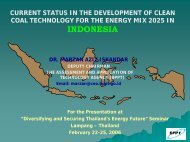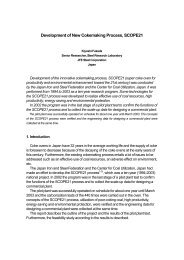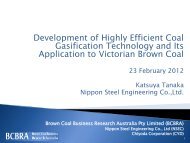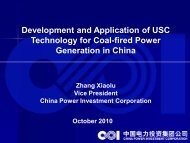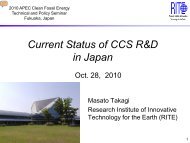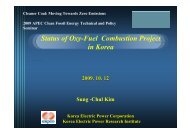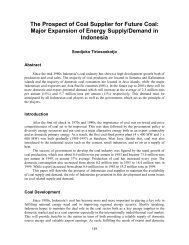Appendix B: Technology Design Options for a Capture <strong>Ready</strong> PlantAppendix B: Technology Design Options for a Capture<strong>Ready</strong> PlantThis appendix describes the key capture technologies, along with several different Capture<strong>Ready</strong> design options for each technology. It provides the incremental initial capital cost andretrofit costs needed for each design, and describes potential advancements in eachtechnology category that could affect both the design and economics of Capture <strong>Ready</strong> plants.B.1 Post-combustion CaptureThe post-combustion capture process is illustrated in Exhibit B-1. Low concentrations ofCO 2 are first captured from the low partial pressure exhaust gas stream in an absorption<strong>to</strong>wer where flue gas is brought in contact with an absorbent solvent (e.g., amine; see below).The CO 2 binds with the solvent at temperatures of 40 <strong>to</strong> 60 o C. The flue gas, now separatedfrom most of its CO 2 , is ready <strong>to</strong> be sent <strong>to</strong> the stack. Meanwhile, the “rich solvent” ispumped <strong>to</strong> the regeneration vessel (or stripper) through a heat exchanger. The stripper hasslightly more than atmospheric pressure and temperatures ranging from 100 <strong>to</strong> 140 o C. 117Under these conditions, the solvent begins the regeneration process and CO 2 is stripped.The heat supplied <strong>to</strong> the regeneration vessel <strong>to</strong> strip CO 2 from the solvent carries asignificant energy cost. The CO 2 is then cooled, dried, and compressed <strong>to</strong> a supercritical fluidstate at which point it can be s<strong>to</strong>red or used commercially. 118 After the removal of CO 2 , the“lean” solvent is cooled and pumped back <strong>to</strong> the absorption <strong>to</strong>wer through a heat exchanger<strong>to</strong> be reused in the process.Exhibit B-1: Post-Combustion CO 2 Capture Process (Absorption)Source: Vattenfall. (2010) 119117 Note that these temperatures are applicable for the amine solvents.118 National Coal Council, Inc. (2008). Advanced coal technologies: Greater efficiency and lower CO2 emissions.119 Vattenfall. (2010). Illustrations. Retrieved from Vattenfall News & Reports website.23 February 2010 76
Appendix B: Technology Design Options for a Capture <strong>Ready</strong> PlantThe post-combustion CO 2 capture absorbent solvents that are most under consideration atthis time are amine, chilled ammonia, and carbonates. CO 2 capture using amine, such asmono-ethanol amine (MEA), is a commercially proven technology. Amine solvents canremove substantial amounts of CO 2 at low pressure and are relatively inexpensive.However, they are corrosive, have high degradation in the presence of oxygen and acidgases, have high solvent losses due <strong>to</strong> fast evaporation, and require a significant amount ofenergy for regeneration. 120 Estimates from the US National Energy Technology Labora<strong>to</strong>ry(NETL) suggest that the low-pressure steam requirements may reduce a unit’s poweroutput by 20 <strong>to</strong> 40%. 121The amine-based chemical absorption process for CO 2 capture is widely used in thebeverage and petrochemicals industries, and consequently commercial amine absorptionsystems are available from a number of vendors.<strong>An</strong> amine scrubbing system is capable of removing between 80% and 95% of the CO 2 from aflue gas stream. However, acidic gases such as NO x and SO x must be removed from the fluegas prior <strong>to</strong> passing through the absorber <strong>to</strong>wer. NO x and SO x react with the amine,resulting in a reduction in solvent performance, higher chemical consumption, and pooreconomic performance.B.1.1 Capture <strong>Ready</strong> Design Considerations for Post-Combustion CaptureGiven that the chilled ammonia-based capture process is not yet commercially available, onlythe amine-based capture systems are described in this appendix. It is <strong>to</strong> be noted, however,that chilled ammonia-based capture is already in the (small-scale) demonstration stage, and ismore likely <strong>to</strong> be commercialized than other options. With amine-based capture, the keyconsiderations for a Capture <strong>Ready</strong> plant are <strong>to</strong> ensure (a) high power plant efficiency, (b) aclean flue gas that is nearly SO x and NO x free, and (c) potential modifications <strong>to</strong> the steamcycle, as large quantities of low-pressure steam are required for the capture process.High Efficiency: High-efficiency (supercritical and ultra-supercritical) pulverized coal (PC)plants will likely be considered first for CO 2 capture retrofitting, due <strong>to</strong> the high efficiencyand capacity penalties of <strong>CCS</strong>.Flue Gas Treatment: Proper treatment of the flue gas prior <strong>to</strong> its entry in<strong>to</strong> the aminebase capture plant is critical, as economic operation of the capture plant is only possiblewith a clean flue gas. Impurities such as particulates, and especially SO x and NO x , need <strong>to</strong> beremoved <strong>to</strong> very low levels. Removal of particulate matter is important <strong>to</strong> reduce thepotential for clogging in the absorber. 121 The acid gas components have an irreversiblechemical reaction with the amines <strong>to</strong> form stable salts that reduce the absorptive capacityand create the risks of solid formation; this results in extra consumption of the solvent <strong>to</strong>maintain effective CO 2 capture rates, and the generation of a waste steam. The IPCC has120 Zachary, J.. (2008). CO2 capture and sequestration options - impact on turbomachinery design. Bechtel PowerCorporation.121 U.S. Department of Energy, National Energy Technology Labora<strong>to</strong>ry (U.S. DOE-NETL). (2008e). Existing Coal PowerPlants and Climate Change: CO2 Retrofit Possibilities and Implications.23 February 2010 77



